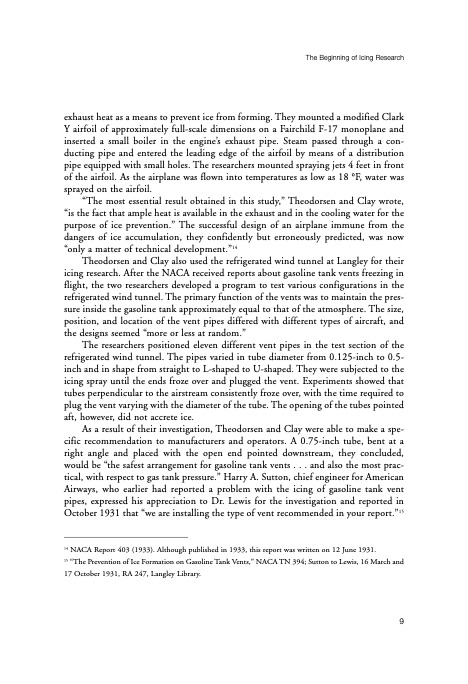
PDF Publication Title:
Text from PDF Page: 022
exhaust heat as a means to prevent ice from forming. They mounted a modified Clark Y airfoil of approximately full-scale dimensions on a Fairchild F-17 monoplane and inserted a small boiler in the engine’s exhaust pipe. Steam passed through a con- ducting pipe and entered the leading edge of the airfoil by means of a distribution pipe equipped with small holes. The researchers mounted spraying jets 4 feet in front of the airfoil. As the airplane was flown into temperatures as low as 18 °F, water was sprayed on the airfoil. “The most essential result obtained in this study,” Theodorsen and Clay wrote, “is the fact that ample heat is available in the exhaust and in the cooling water for the purpose of ice prevention.” The successful design of an airplane immune from the dangers of ice accumulation, they confidently but erroneously predicted, was now “only a matter of technical development.”14 Theodorsen and Clay also used the refrigerated wind tunnel at Langley for their icing research. After the NACA received reports about gasoline tank vents freezing in flight, the two researchers developed a program to test various configurations in the refrigerated wind tunnel. The primary function of the vents was to maintain the pres- sure inside the gasoline tank approximately equal to that of the atmosphere. The size, position, and location of the vent pipes differed with different types of aircraft, and the designs seemed “more or less at random.” The researchers positioned eleven different vent pipes in the test section of the refrigerated wind tunnel. The pipes varied in tube diameter from 0.125-inch to 0.5- inch and in shape from straight to L-shaped to U-shaped. They were subjected to the icing spray until the ends froze over and plugged the vent. Experiments showed that tubes perpendicular to the airstream consistently froze over, with the time required to plug the vent varying with the diameter of the tube. The opening of the tubes pointed aft, however, did not accrete ice. As a result of their investigation, Theodorsen and Clay were able to make a spe- cific recommendation to manufacturers and operators. A 0.75-inch tube, bent at a right angle and placed with the open end pointed downstream, they concluded, would be “the safest arrangement for gasoline tank vents . . . and also the most prac- tical, with respect to gas tank pressure.” Harry A. Sutton, chief engineer for American Airways, who earlier had reported a problem with the icing of gasoline tank vent pipes, expressed his appreciation to Dr. Lewis for the investigation and reported in October 1931 that “we are installing the type of vent recommended in your report.”15 The Beginning of Icing Research 14 NACA Report 403 (1933). Although published in 1933, this report was written on 12 June 1931. 15 “The Prevention of Ice Formation on Gasoline Tank Vents,” NACA TN 394; Sutton to Lewis, 16 March and 17 October 1931, RA 247, Langley Library. 9PDF Image | History of NASA Icing Research Tunnel

PDF Search Title:
History of NASA Icing Research TunnelOriginal File Name Searched:
sp4226.pdfDIY PDF Search: Google It | Yahoo | Bing
NFT (Non Fungible Token): Buy our tech, design, development or system NFT and become part of our tech NFT network... More Info
IT XR Project Redstone NFT Available for Sale: NFT for high tech turbine design with one part 3D printed counter-rotating energy turbine. Be part of the future with this NFT. Can be bought and sold but only one design NFT exists. Royalties go to the developer (Infinity) to keep enhancing design and applications... More Info
Infinity Turbine IT XR Project Redstone Design: NFT for sale... NFT for high tech turbine design with one part 3D printed counter-rotating energy turbine. Includes all rights to this turbine design, including license for Fluid Handling Block I and II for the turbine assembly and housing. The NFT includes the blueprints (cad/cam), revenue streams, and all future development of the IT XR Project Redstone... More Info
Infinity Turbine ROT Radial Outflow Turbine 24 Design and Worldwide Rights: NFT for sale... NFT for the ROT 24 energy turbine. Be part of the future with this NFT. This design can be bought and sold but only one design NFT exists. You may manufacture the unit, or get the revenues from its sale from Infinity Turbine. Royalties go to the developer (Infinity) to keep enhancing design and applications... More Info
Infinity Supercritical CO2 10 Liter Extractor Design and Worldwide Rights: The Infinity Supercritical 10L CO2 extractor is for botanical oil extraction, which is rich in terpenes and can produce shelf ready full spectrum oil. With over 5 years of development, this industry leader mature extractor machine has been sold since 2015 and is part of many profitable businesses. The process can also be used for electrowinning, e-waste recycling, and lithium battery recycling, gold mining electronic wastes, precious metals. CO2 can also be used in a reverse fuel cell with nafion to make a gas-to-liquids fuel, such as methanol, ethanol and butanol or ethylene. Supercritical CO2 has also been used for treating nafion to make it more effective catalyst. This NFT is for the purchase of worldwide rights which includes the design. More Info
NFT (Non Fungible Token): Buy our tech, design, development or system NFT and become part of our tech NFT network... More Info
Infinity Turbine Products: Special for this month, any plans are $10,000 for complete Cad/Cam blueprints. License is for one build. Try before you buy a production license. May pay by Bitcoin or other Crypto. Products Page... More Info
| CONTACT TEL: 608-238-6001 Email: greg@infinityturbine.com | RSS | AMP |